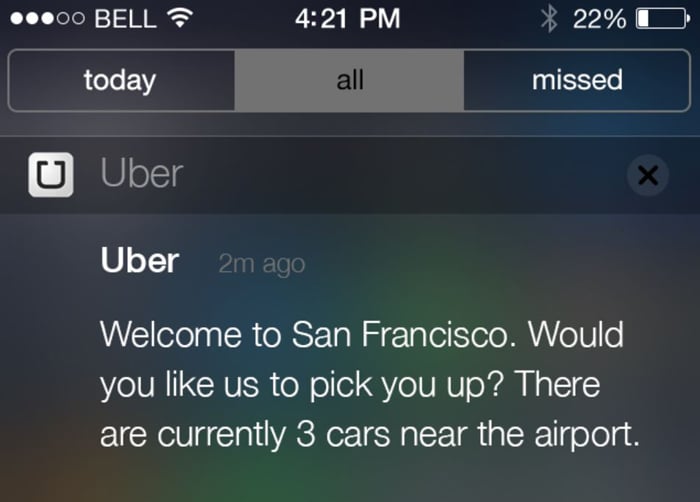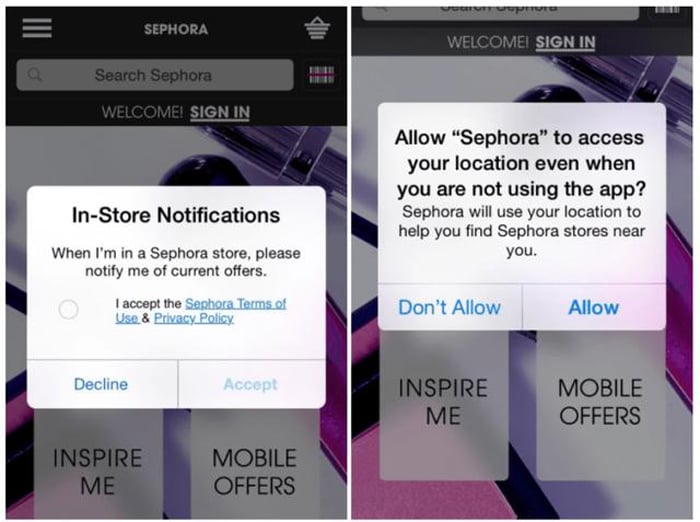What’s geofencing advertising?
Imagine walking into a mall and receiving a Starbucks voucher on your smartphone. You look up to see a Starbucks store.
This scenario can encourage you to visit the point of sale, find out about the promotion and use the coupon.
With geofencing marketing or location-based marketing, this convenient strategy becomes a reality.
How can you use it?
Let's start by discussing the basics.
What Is Geofencing Marketing And How Is It Used?
Geofencing enables businesses to advertise to consumers in a specific geographic area.
With technologies like GPS and radio frequency IDs, marketers can set a scope or limit based on a real-world location. Then they can create a virtual barrier or "geofence" in the region.
When consumers enter the geofence, they receive location-based ads on their devices.
Consider this geolocated Uber ad for incoming tourists:

Geolocated ads can be useful if you:
- Increase pedestrian traffic: Brands can send cell phone ads, coupons, or notifications to lure customers to their stationary locations.
- Crowd engagement: Organizations and companies hosting events, festivals or concerts can use it to attract those close to their stands.
- Competitor target customers: Businesses can set up a geofence at a competitor's location to attract more customers to their stores.
- Understand consumer behavior: With geofencing, brands can summarize consumer behavior such as time spent in store or how visitors navigate their stores.
Advantages of geofencing marketing
Geofencing Marketing offers many potential benefits to brands and marketers whether they are in-store or online. If you're thinking about diving in, here are a few potential benefits to consider.
Geofencing can help with local marketing
People are more interested in getting out of their homes, especially on foot, than ever before. This means that it is becoming increasingly important to speak to people when they walk past businesses.
This is not a small increase: A Billups study found that 71 percent of consumers are more interested in simply walking around their neighborhoods or cities than they used to be. Many would also like to visit outdoor pop-up shops when hiking.
As more and more people want to visit stores and travel around their communities on foot, location-based marketing offers great potential. You don't have to worry about people passing by too fast to receive or use the notification.
We also have evidence that this method works even when people drive by instead of walking. According to QSR magazine, a company conducted an experiment to determine the effectiveness of location-based ads in increasing breakfast sales.
When setting up a geofence, the participating point of sale saw in-store visits increased by 20 percent and visits during breakfast hours by 26 percent.
Get data on consumer behavior
Unlike online marketing, geo-targeted ads enable companies to collect real-time data about consumers with high purchase intent.
After a while, you can use this information to improve your targeting and advertising methods and improve your results.
Geotargeting can also reveal interesting customer insights. Anonymous location data can display the other outlets customers visit, billboards they may notice, and streets or areas they visit frequently.
This means marketers can identify ideal billboard or signage placements to improve outdoor advertising results or see which other physical stores are real competitors.
Increase your brand awareness
Geotargeted advertising can also increase brand awareness and promote your online channels.
Remember the hypothetical situation of noticing a Starbucks after receiving a targeted ad on your phone? That Starbucks could be any store you otherwise passed without realizing it was where it wasn't for notification.
These ads are a great way to remind customers that you exist and to let them know that you are right there to serve them. This makes them more aware of your brand and your location.
How to integrate geofencing into your marketing strategy
Location-based ads may be ideal for businesses looking to drive traffic to their online or in-person businesses.
While geofencing has many advantages, it can be a little more expensive than digital ads.
A geofencing campaign ranges from $ 3.50 to $ 15 CPM (cost per mile) for desktop and mobile campaigns. By comparison, the average cost per click on the Google AdWords search network is $ 2.32.
Still, if you're ready to give it a try, here are some tips to help you implement this strategy successfully.
Find the ideal size for your geofence
A larger geofence is more expensive than a small one, but in this case a larger one may not be better.
For example, if your geofence is within 25 miles of your store, you may be spending money on distant customers who don't have the time to stop by.
Instead of a large geofence, I recommend creating several small perimeters. Ideally, the perimeter should be no more than a five-minute walk from your store.
You don't just get stuck with the size of your business, however. In some cases it can be a good idea to set up geofences at events. For example, if your small business has a stall at a farmers market or even a music festival, you can send out messages letting people know you are there.
Know your audience
As with all marketing campaigns, understanding your target audience is key to getting results.
Identify their age, gender, interests, and shopping habits to improve the accuracy of your ad targeting strategies. What do you like about your business? Why did they care about your brand?
In addition to answering these questions, understanding your target audience can help you create compelling copies and ads that people will respond to.
Start an actionable ad
Don't just talk about what you are selling. Flag in-store promotions or give out rewards for replying to the ad. If they are your target audience, they may already know who you are – give them a reason to come in.
For example, this is a personalized notification that Starbucks sends to nearby customers. Not only do they mention the customer's name, but they also contain an advertisement for their favorite drink.

Add a compelling CTA
Top it off with a compelling CTA to sweeten the deal.
A Reveal Mobile report found that the top performing CTAs for geolocated ads include:
- Learn more
- Shopping now
- buy now
- Click here
Marketers have also seen success with other CTA flavors such as “Order Now,” “Click to Save,” “Call Now,” and “Shop Online”.
Use multiple targeting options
Geolocated ads have several targeting techniques that can help you communicate effectively with your target audience.
Let's look at the following variations:
- Dayparting: Target audience for users at a specific time of the day.
- Behavioral targeting: Show advertisements about user behavior.
- Context targeting: Show ads based on websites visited.
- Retargeting: Sending advertisements to previous online visitors and former customers
Track the success of your geofencing marketing campaigns
You need to track relevant KPIs and metrics to determine if your geolocated marketing campaigns are effective. The good news is that current marketing technologies allow users to collect data for their campaigns.
Here are some metrics to consider:
- Ad impressions or views: The number of times your ad is seen.
- Click through rate (CTR): Number of clicks your ad receives per number of impressions.
- Cost per 1000 impressions (CPM): Amount you pay per 1000 impressions.
- Cost per click (CPC): The highest amount you pay for a click on your ad.
- Visits to the conversion zone: The number of people who visited your store or specific location while viewing your ad.
- Cost per visit: Total number of visits to your store divided by the cost of your marketing efforts.
- Costs per action (phone call, walk-in, sales): Amount you pay to generate a conversion.
- Walk-in rate: The percentage of people on a street that walk into your store.
You can change your ads based on your results. If passers-by don't respond to your push notifications, change your copy or promos.
Geofencing Marketing Ethical Considerations
When it comes to location-based ads, privacy is the most important ethical consideration.
Laws like the California Consumer Privacy Act (CCPA) and the General Data Protection Regulation (GDPR) in the EU are dedicated to protecting consumer data.
More than 80 countries have digital privacy regulations in place and more invoices will be audited in the coming years.
While most location-based advertising technologies generate anonymized data, location data is still personal information. Additionally, someone's search history and browsing data must remain private.
Businesses can protect themselves and their consumers while implementing geofencing by complying with the consumer rights directives of the GDPR and the CCPA.
This includes the following:
- Consumers can ask what information is being collected and why.
- When prompted to do so, you must provide the collected data to consumers.
- Individuals can deactivate this data collection.
- You can only use the information for the reasons you have specified.
You have probably already seen companies that meet these expectations. For example, with the Sephora app, customers can enable or disable location services and branch notifications:

Conclusion
Geofencing marketing can be an effective way to drive traffic to your business, website, or even social media channels.
Remember, potential customer locations are not enough: you also need to figure out who your target audience is and create ads that will be sent directly to them.
As long as you know the right steps, you can create your own geographic marketing campaigns. We strongly recommend monitoring your results, creating compelling CTAs, and understanding your target audience for maximum effectiveness.
How will you use geolocated ads for your business?

See How my agency can drive Firmly Amounts of traffic on your website
- SEO – Unlock tons of SEO traffic. See real results.
- Content Marketing – Our team creates epic content that is shared, links accessed and visitors drawn.
- Paid media – effective paid strategies with a clear ROI.
Book a call
